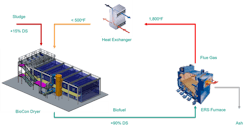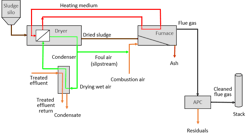Destroying PFAS in Sludge
Jon Orr is product manager for Veolia Water Technologies. Orr can be reached at [email protected]. Sudhakar Viswanathan is national sales manager for Veolia Water Technologies. Viswanathan can be reached at [email protected].
undefinedRising concerns over per- and polyfluoroalkyl substances (PFAS) contamination of water and soils have sparked interest in this emerging class of contaminants as it pertains to wastewater sewage sludge. Two groups of PFAS are of particular concern for human health and the environmental perspectives, namely perfluoroalkyl sulphonates (PFOS) and perfluorooctanoate (PFOA), especially in regards to their persistent and bioaccumulative nature.
Due to the extensive use of PFAS compounds for over eight decades, including in everyday household items such as food packaging, cookware, stain-resistant clothing and industrial applications like electroplating and firefighting foam, it is generally accepted that nearly all wastewater treatment sludges will have some trace background level of PFAS compounds.
Are PFAS Found in Land Application Biosolids?
Wastewater sludges have been found to have perfluoroalkyl carboxylates (PFCAs) and perfluoroalkane sulfonates (PFSAs), and additional compounds such as GenX are being detected in liquids and solids as analytical methods improve. The fate and transport of PFAS compounds from biosolids to crops or soil is unknown, with some studies indicating that biosolids used for soil amendment can result in the transfer of PFAS to soil, with PFAS being available for uptake by plants and soil organisms.
Numerous states already require testing for PFAS in sludge prior to land application, or monitor industrial pretreatment programs in an effort to identify and eliminate the potential for PFAS entering wastewater treatment facilities that discharge into the environment. According to a report in the Detroit Free Press, the Michigan Department of Environmental Quality has identified more than 11,000 sites contaminated with PFAS compounds in Michigan alone, with more than 46 sites statewide showing levels above the U.S. EPA’s health advisory limit of 70 parts per trillion in groundwater.
While the concentrations of PFAS compounds in sludge are relatively low, the need to identify a safe option for the ultimate disposal of PFAS contaminated sludge is warranted.
Traditional Wastewater Treatment Methods in the U.S.
Traditionally in the U.S., sludge is alkaline-stabilized and land applied. The alkaline stabilization process involves the addition of lime to wastewater sludge and the raising of pH to approximately 12 for a contact period of no less than two hours, with numerous other operational methods to yield varying degrees of treatment. The resulting sludge quality varies, but in general, the technique is only capable of removing fecal coliform and salmonella, not ova of parasites or more complex compounds such as PFAS.
Alternatively, sludge can be digested aerobically or anaerobically at varying temperature ranges to successfully eliminate ova of parasites, but neither of these processes are known to remove PFAS compounds. These methods pose a potential threat in terms of PFAS exposures as these compounds can exit those processes and transport into the natural environment when biosolids – although stabilized to Class A or EQ quality – are land applied or landfilled.
Thermal Oxidation & PFAS Destruction
Literature research suggests that thermal oxidation can be employed for complete and ultimate destruction of PFAS from sludge. PFAS compounds, such as PFOS when combusted, breaks down into easily scrubbed and separated gases such as CO2, H2O and HF. In the early 2000s, previous studies have indicated that degradation of PFOS occurs at temperatures above 600°C. This also, however resulted in the formation of potent greenhouse gases CF4 and C2F6.
Another related study showed that thermal treatment of PFOS-contaminated sludge with an addition of Ca(OH)2 reduces the emissions of CF4 and C2F6 in favor of CF3H and formation of solid CaF2 and Ca5(PO4)3F.
A subsequent study found that combustion of PFAS does not result in PFOS by-products. This is critical while applying combustion as the treatment for PFAS-laden sludge. Current research efforts are indicating that combustion processes at higher temperatures can be adapted to mitigate these issues and properly address the challenge of evolving emission standards.
Combining Thermal Drying & Thermal Oxidation Processes
With thermal oxidation as the leading contender for the destruction of PFAS compounds in sludge, the focus of this research turned to established technologies that can be readily deployed to address the market’s needs. Veolia Water Technologies has developed and successfully installed a safe and sustainable drying and combustion system in the municipal wastewater management market using a system called BioCon ERS.
This system combines the efficiencies of a convective air medium temperature belt dryer with a biomass furnace. The purpose is to completely combust all organic material and recover sensible heat. The heat available in the exhaust is captured for use as process heat in the belt dryer. This integrated dryer and energy recovery system is sustained by heat generated from the combustion of biosolids to drive the drying process, and in turn the dried material fuels the combustion system, making it a fully energy sufficient and sustainable system.
While the use of BioCon ERS for PFAS destruction is new, the concept of combining these two technologies is not. For example, the city of Buffalo, Minnesota, had been beneficially using biosolids as a fuel source at the Buffalo Wastewater Treatment Facility (WWTF) using this process scheme since 2008. The solids treatment system at Buffalo WWTF consists of both BioCon thermal drying and ERS thermal oxidation processes to reduce the amount of material leaving the site while minimizing overall fossil fuel consumption.
The thermal treatment process consists of several steps as depicted in the process flow diagram above. Dewatered solids are pumped from a storage silo, into the dryer cabinet through oscillating depositors, and onto a slowly moving belt inside the dryer. Heat is transferred to the solids by circulating air between an air-to-air heat exchanger that recovers energy from the furnace flue gas and the dryer cabinet. Moisture is removed from the drying air by continuously extracting a portion of the air from the dryer, transferring it through a condenser and returning it back to the dryer.
A portion of the air from the condenser is removed from the system to maintain a negative pressure on the drying system. The foul air is blended with fresh air and is used as combustion air in the burners and furnace to eliminate the need for separate odor control systems.
Knowing the flexibility this combined system offers, the research turned the focus on determining the efficacy of treating PFAS-laden sludge using this system that has been proven for more than a decade.
Bench Scale Oxidative Study
Led by Veolia, a bench scale oxidative study was undertaken in collaboration with the University of Dayton Research Institute in Ohio. The goal was to study the fate and transport of PFAS in sludge undergoing full combustion and its impact on solids residue, process liquids and air emissions.
The experimental setup included a thermal reactor that is a batch-charged, continuous flow reactor system. This system was configured to represent gas-phase behavior in a full-scale waste incinerator prior to air pollution controls. This set up allows the study of combustion at various conditions, including adjustments to temperature, oxygen applied and dwell time to mimic controllable conditions within the ERS.
The study was conducted in two phases. Phase 1 involved the determination of transport efficiency of the laboratory setup to ensure PFAS can be captured for analytical confirmation. Phase 2 involved the thermal oxidation of PFAS-laden sludge to determine if PFAS can be decomposed at designated temperatures that mimic a full-scale ERS biomass furnace.
Results from Phase 1 suggest that transport efficiency is greater than 80%. Results from the Phase 2 study demonstrate that complete degradation of PFAS compounds under optimal thermal oxidation is possible.
Based on the results obtained and the decomposition rates calculated thus far, PFAS destruction using the proposed treatment train is achievable and exceeds treatment objectives. An attempt to develop as fluorine mass balance is underway. Due to the highly reactive nature of HF and the low limit of quantitation of HF analysis, it is possible that a fluorine mass balance could result in poor outcome or is not achievable.
Results from this study are being used to industrialize a full-scale thermal oxidation solution for the treatment of PFAS-laden sludge. Veolia continues with studies aimed at fine-tuning the industrial scale treatment scheme and further optimization of the air pollution control scheme are underway


